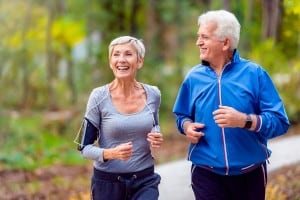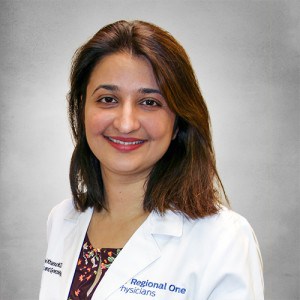- During menopause, falling estrogen levels can lead to lower bone density, making women susceptible to fractures.
- OB/GYN Pallavi Khanna, MD recommends a DEXA scan for bone density for women over age 65.
- Depending on the results of the scan, she can help patients build stronger bones through lifestyle changes and medication.
It’s a story you hear far too often: A senior citizen falls and breaks a bone. It starts a downward spiral that can lead to a less active lifestyle, more fractures and even death.
One way to help prevent that is to know your osteoporosis risk and take steps to build stronger bones. That is especially important for menopausal women, says Pallavi Khanna, MD, OB/GYN, a Certified Menopause Practitioner at Regional One Health.
“Estrogen levels drop during menopause, which contributes to lower bone mass,” Dr. Khanna said.
“That can lead to an increased vulnerability to fractures, and fractures can be very hard to recover from as we age. They can beget more fractures, stop patients from getting back to their previous lifestyle or even lead to premature death.”
A DEXA scan screens for osteoporosis and its precursor, osteopenia. The test is available at the East Campus Imaging Center with a doctor’s order, and Dr. Khanna recommends it for all post-menopausal women age 65 and over.
She also orders the test for younger women if medically necessary, i.e. if they’re at a high risk for osteoporosis. Aside from age, risk factors include:
- Long-term use of steroids for conditions like arthritis or lupus
- A history of fractures, especially if they occur from a seemingly minor incident
- Heavy alcohol use
- Smoking
- A sedentary lifestyle
- Low calcium intake
The DEXA scan takes 5-10 minutes and is non-invasive and painless.
Patients lie flat on a table while an X-ray machine scans over them. They don’t even have to undress.
The machine scans the patient’s lumbar, spine and hips.
A radiologist reads the results and gives the patient a number that indicates their risk for osteoporosis or osteopenia.
Based on the diagnosis, doctors can help in many ways, Dr. Khanna said. Lifestyle changes are the first line of defense:
- Give up smoking and excessive alcohol use.
- Get between 1,000 and 1,200 mg of calcium daily. It is best to get it from food, such as dairy products and leafy green vegetables.
- Get 600-800 IU of vitamin D daily. Getting vitamin D, which helps the body absorb calcium, from food and the sun is optimal.
- Do weight-bearing exercise like walking, jogging or weightlifting. Dr. Khanna suggests keeping ankle weights near your desk or favorite chair to use throughout the day.
There are also medications that treat osteoporosis and osteopenia, Dr. Khanna said.
She can talk to patients about effective, safe use of vitamin D and calcium supplements.
Also, “Hormones have a big role to play in bone mass. Androgen helps stop the breakdown in bones, and estrogen actually builds bone mass,” Dr. Khanna said.
She noted hormones also treat other menopause symptoms, like hot flashes and vaginal dryness.
As a Certified Menopause Practitioner she can help patients navigate the options.
Finally, Dr. Khanna said, prevention is worth a pound of cure when it comes to osteoporosis. She counsels patients on fall prevention in their home. “It’s very easy to trip and fall when you walk,” she said. “Patients need to be aware of preventing hazards in their homes.”
Her suggestions include:
- Install a walk-in shower and use non-skid strips in bathtub and shower.
- Secure loose rugs or carpets.
- Have enough light in passageways that you can see where you’re going at night.
- Store items where you don’t need a step stool to reach them.
- Make sure cords and cables don’t pose a tripping hazard.
- Remove clutter: “If your grandkids come visit, make sure you put the toys away before you go to bed!” Dr. Khanna said.
Bone health is an important consideration for all of us as we age, and post-menopausal women should be especially vigilant.
Don’t try to go it alone – talk to your doctor today about your risk and how you can keep your bones healthy for an active life.
“Osteoporosis is not the simplest thing to treat,” Dr. Khanna noted. “You want to listen to the patient and see what other things are happening.”


